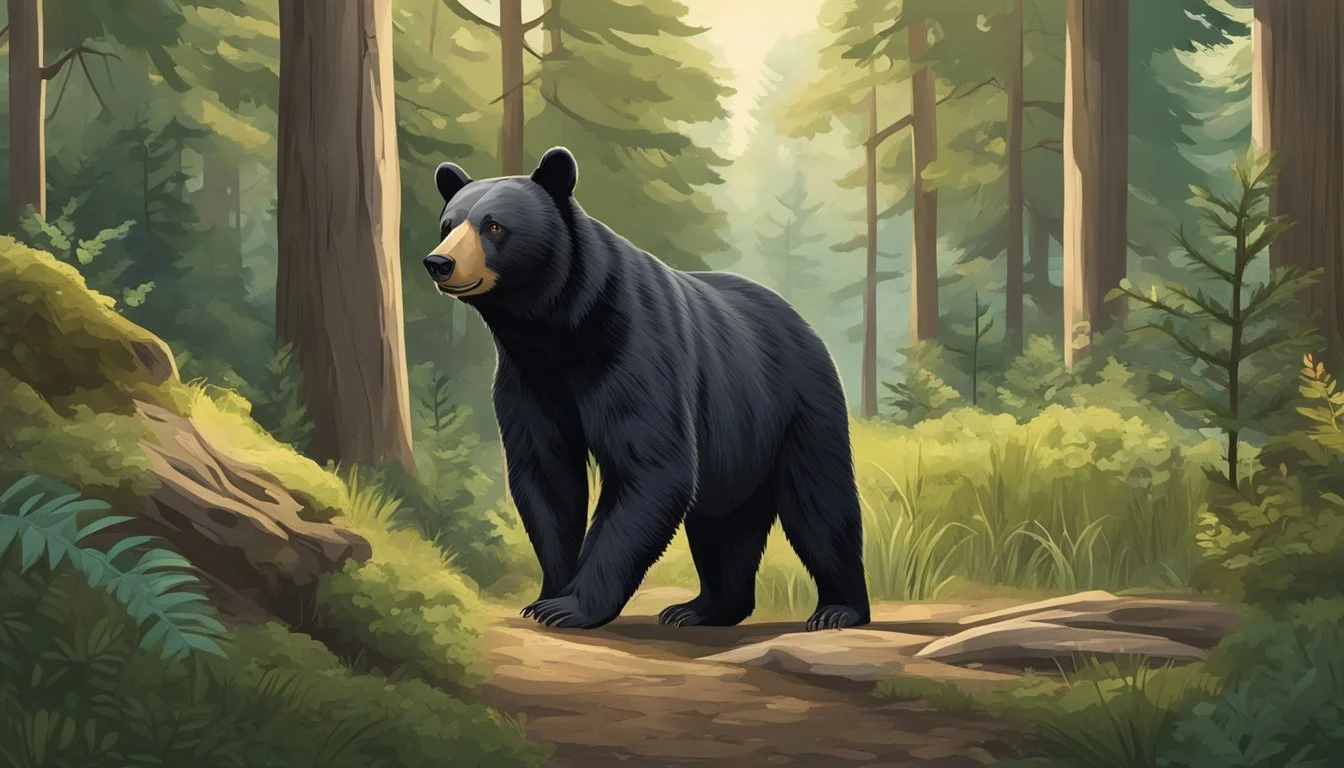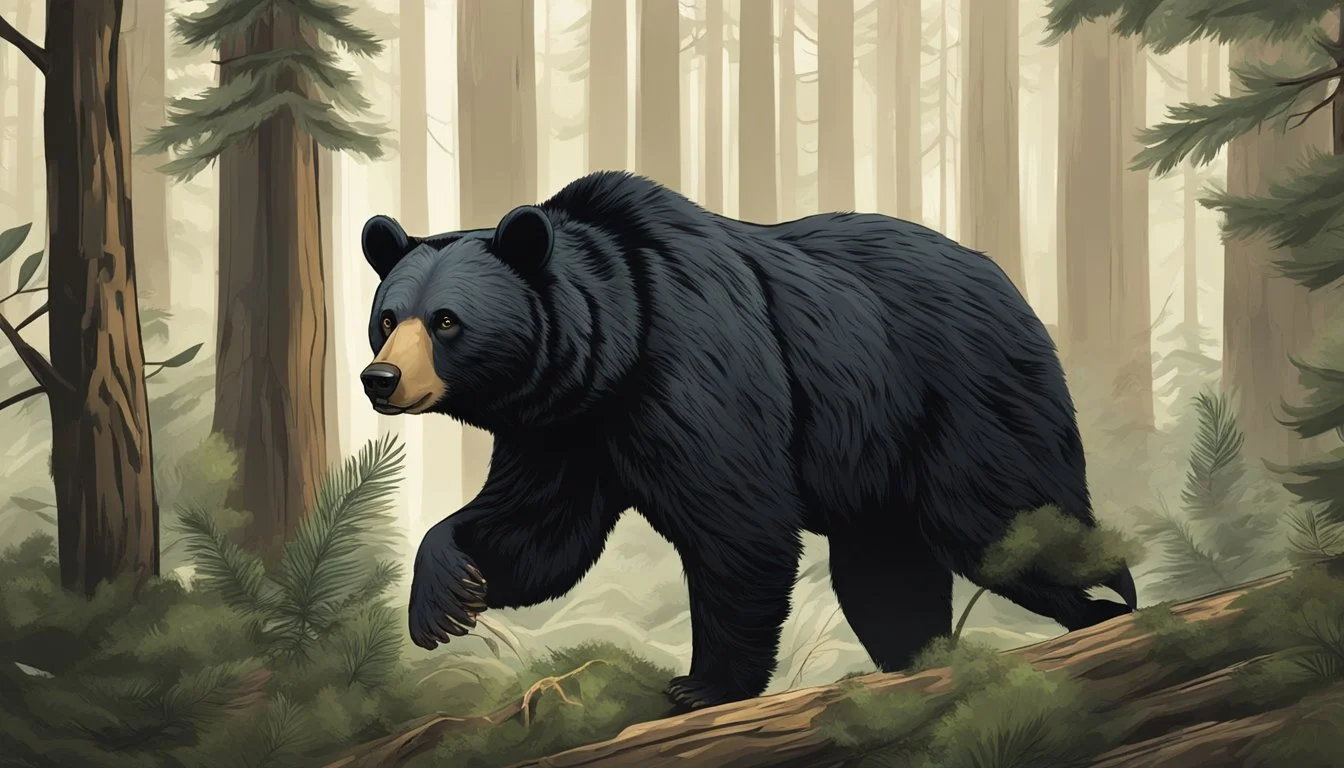Black Bear Hunting for Beginners
Gear, Safety, and Regulations
Black bear hunting is an activity that appeals to many types of outdoor enthusiasts seeking the challenge of big game animals. The American black bear is the most widely distributed bear species in North America, with an estimated population in hundreds of thousands. These animals can be found across twenty-eight US states and all Canadian provinces, boasting significant numbers in regions like Maine, which has a reputation for having a particularly large bear population. Black bears are generally found in forested areas, but they have shown a remarkable ability to adapt to many environments.
Pursuing black bears requires substantial knowledge of bear behavior, habitat, and life cycle. Hunters must become familiar with identifying the presence of bears, locating feeding areas, and understanding seasonal changes in behavior. Ensuring a successful and ethical hunt involves learning proper shot placement, the correct use of bait or other attractants, and often using the assistance of experienced guides. Regulations vary widely by state, including permit requirements and seasons, making research and preparation a vital part of planning a hunt.
With such a broad distribution of the population and varying hunting regulations, black bear hunting can offer a scope of experiences, ranging from spot-and-stalk adventures in the remote wilderness to more controlled hunts in managed areas. Whether the objective is for trophy, conservation, or bear meat, hunting bears continues to be a revered tradition that encourages a deepened understanding of one of North America's most iconic species.
Overview of Black Bear Hunting
Like other big game animals hunting Black bears combines tradition with understanding the species' behaviors and habitats. This section explores the prevalent history and popularity of the pursuit, and the typical habitats of black bears in North America.
History and Popularity
Hunting bears is a time-honored practice in North America with roots among indigenous peoples and European settlers who originally hunted for bear meat. Today, it is a regulated activity enjoyed by hunters for its challenge and for population management. It is part of a broader cultural appreciation for wildlife and wilderness skills.
Black Bear Habitats in North America
Black bears are adaptable and can be found across various North American landscapes. They generally prefer forested areas with access to water and dense vegetation. Here, they exhibit relatively small home ranges.
Typical habitats include:
Deciduous forests
Mixed coniferous-deciduous forests
Mountainous regions
Coastal areas
Swamps and wetlands
These regions provide:
Ample forage
Cover for denning
Seclusion from human encroachment
Legal Framework and Regulations
In the United States, hunting methods for bears are governed in such a way by laws that ensure ethical practices and sustainable wildlife populations. Laws vary significantly by state, and hunters are required to adhere to each jurisdiction’s specific hunting regulations.
Understanding Hunting Laws
The legal framework for hunting black bears comprises a variety of regulations, such as the requirement for a hunting license and a specific bear hunting permit. Hunters are typically limited to a certain number of bears per season, and they must use legal weapons. Regulations also may dictate acceptable hunting methods, seasons, and reporting requirements post-harvest. These laws are in place to manage bear populations, prevent overhunting, and maintain ecological balance.
State-Specific Regulations
Each state has its own set of rules regarding hunting for bears. For instance:
California: Hunting of black bears in California is regulated by the California Department of Fish and Wildlife. As of 2023, hunters can check the black bear harvest total, which is updated weekly.
Wisconsin and Idaho: While specific regulations for these states are not detailed in the provided search results, both typically have their own regulatory frameworks, which can include season dates, harvest limits, and designated wildlife management areas.
Alaska: Known for its robust populations of brown and black bears, Alaska allows individuals to hunt bears under specific regulations, such as applying for the appropriate permits and licenses.
Hunters must thoroughly research and comply with the regulations of the state where they plan to hunt. Each state’s wildlife agency can provide resources such as handbooks, maps, and up-to-date news on regulatory changes or requirements for the respective hunting season.
Preparation for the Hunt
Proper preparation is critical for a successful black bear hunt. It involves a combination of physical readiness and selecting appropriate gear.
Physical Fitness and Training
A hunter must be physically fit as traversing rugged terrain and possibly tracking game for long distances is often involved when you hunt bears. Cardiovascular training such as running or hiking can be beneficial. Strength training should also not be neglected, focusing on core muscles, legs, and arms which will be essential for steadiness during a shot and for field-dressing the game.
Choosing the Right Equipment
The selection of equipment is paramount to a hunter's success.
Rifles and Optics: A reliable rifle is a necessity. Hunters often prefer more powerful rifles in calibers that are suitable for bringing down medium to large game, such as .30-06 or .308. Optics play a crucial role, and a quality scope with good light transmission will help in low-light conditions; 8x to 10x magnification scopes are commonly used.
Equipment Type Recommendations Rifles .30-06, .308 Optics 8x to 10x scopes
Proper preparation involves a mix of physical fitness and carefully choosing equipment that will perform in the varied conditions a hunter may face when tracking a Black bear.
Techniques for Black Bear Hunting
In hunting the Black bear, success hinges on mastering various techniques such as glassing from strategic positions, employing stealth in stalking, understanding effective baiting practices, and utilizing calls. Each approach requires a hunter's keen awareness of the bear's habits and sensory strengths.
Glassing and Observation
Hunters use glassing to locate their Black bear from a distance without detection. This involves scanning the landscape with binoculars or spotting scopes from an elevated vantage point. The hunter needs to remain still and silent, making use of natural cover to avoid being spotted by these observant creatures.
Stalking Strategies
Spot and stalk hunting entails cautiously moving closer to the bear once spotted, often utilizing natural terrain features to stay concealed. A hunter must understand wind direction to remain downwind of the bear, as a black bear's sense of smell is highly developed and can easily alert it to human presence. Spot and stalk hunting is more suited to open or semi-open spaces, where a hunter can locate his prey remotely, be it a Black bear or Grizzly bear, before moving forward into killing distance without alerting the animal.
Baiting Practices
Effectively baiting bears involves placing attractants like food in an area bears frequent, to entice them into the open. The bait must be strategically positioned near game trails and away from wind paths leading to the hunting blind or tree stand. Trail cameras are often used to monitor activity and adjust tactics accordingly.
Bait site selection: Choose an area with fresh bear sign.
Scent control: Use scent-free gloves when handling bait.
Regularity: Refresh the bait regularly to keep the site active.
Tree stand: In some states and provinces, bears are hunted using bait with the hunter in a tree stand or blind.
Calling Techniques
Calling mimics the sounds of prey or other bears, drawing them towards the hunter. The sounds big bears make vary between species: Black bears make a long huff, growl, high-pitched bark, or a woof. In comparison, the Grizzly bear makes a huff, a jaw-pop using the bear skull, and a low growl. It can be challenging due to a bear's acute hearing, but it's highly effective when performed correctly. Two main types of calls are used:
Predator Call: Imitate wounded animals, such as an injured bear as bears tend to follow their curiosity.
Cub-in-Distress Call: Mimic the sounds of a young bear, appealing to adult bears' protective instincts.
Each technique demands discipline, skill, and respect for the bear's capabilities and environment on Black bear hunts.
Safety and Ethical Considerations
When engaged in bear hunts, the bear hunter must prioritize safety and adhere to ethical guidelines. They bear the responsibility of minimizing risks to themselves and ensuring that the pursuit respects bear populations and their habitat.
Safety Measures:
Bear Spray: Hunters should carry bear spray as a non-lethal deterrent for close encounters.
Knowledge of Bear Behavior: Understanding bear behavior can prevent confrontations during a bear hunt. With knowledge of even the most basic bear anatomy hunters appreciate just how powerful a Black bear can be, especially when angered.
Food Storage: Properly storing food and attractants in bear-proof containers reduces the risk of unwanted interactions of multiple bears .
Respect for Nature: Hunters should value the life of the bear and the balance of the ecosystem on a bear hunt.
Humane Methods: Employing quick and efficient methods to minimize suffering is imperative.
Legal Compliance: Following all local hunting regulations, including seasons and limits, maintains sustainable bear populations.
When considering these practices, hunters are also expected to contemplate the broader implications of bear hunting on conservation efforts and societal perspectives. They are encouraged to engage in open dialogues about ethical considerations, addressing concerns such as animal cruelty and the ecological role of big bears. By upholding both safety and ethics, hunters contribute to responsible wildlife management and conservation.




